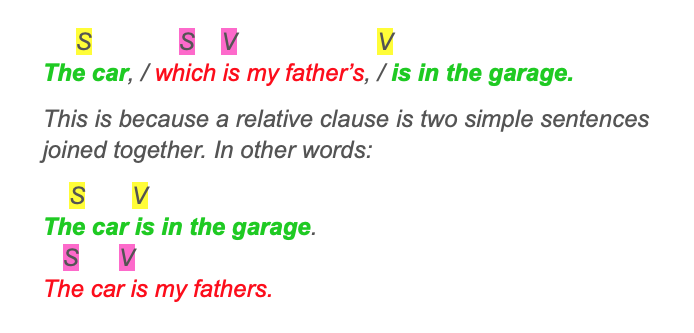- Home
- Relative Clauses
Relative Clauses
Relative clauses, also known as adjective or attributive clauses, are a type of complex sentence in English grammar.
The two main types are defining and non-defining relative clauses. They will start with a relative pronoun or a relative adverb. We can also reduce relative clauses into present or past participle phrases.
It's important to know how to use them in order to avoid writing relative clause fragments. Below is an explanation of these clauses and how to use them.
Watch a Video Explaining Relative Clauses
Watch a short video summarising the grammar of relative clauses.
About Relative Clauses
What do relative clauses do?
Relative clauses describe or provide information about someone or something (a noun or noun phrase) that has usually already been specified:
Information about a noun/noun phrase:
I like mixing with people who are well read.
- Who refers to 'people'
She ate too much, which led to her putting on a lot of weight.
- Which refers to 'she ate too much'
Relative clauses are also a way in which clauses can be combined so that we do not repeat ourselves:
Avoid repeating nouns/noun phrases:
I bought a new car. The car has a sun roof.
- I bought a new car, which has a sun roof.
I tried to write the whole essay in one hour. Writing the whole essay in one hour wasn't possible.
- I tried to write the whole essay in one hour, which wasn't possible.
So a less awkward way of speaking/writing is achieved as 'car' is not repeated in the first example and 'write the whole essay' in the second.
How do I recognise relative clauses?
Relative clauses begin with one of these relative pronouns:
- who
- that
- which
- whose
- whom
- what
Or one of these relative adverbs:
- where
- when
- why
These words though, are not just used for relative clauses, so you can't assume if you see one it is a relative clause.
It is the sentence position and the context that will tell us whether it is a relative clause or not.
Where do they appear in a sentence?
Relative clauses follow whatever it is that they are qualifying.
They commonly qualify or give more information about a noun. This is why they are also known as adjective clauses.
An adjective describes or clarifies a noun, and in a similar way, a relative or adjective clause gives more information about or defines a noun.
In this case they will come directly after the noun:
1. After the noun:
I bought a new car (noun), which has a sun roof.
- The further information is that the car has a sun roof.
I like mixing with people (noun) who are well read.
- The relatives clause clarifies that it is well read people that the person likes to mix with
If they are qualifying a whole clause, then they come directly after that clause:
2. After the whole clause:
I tried to write the whole essay in one hour, which wasn't possible.
- 'Which' refers to the writing of the essay in one hour, so it comes directly after that whole clause
You'll have noted in the above examples that the relative clause comes after the main independent clause.
However, they can also spit up the independent clause. This is if they are qualifying a noun which is the subject of the sentence, in which case they are embedded within the main clause:
3. After the subject:
The students (subject) who studied the hardest got the highest scores in the test.
Canberra (subject), which is the capital of Australia, is a relatively new city.
Subjects and Verbs
When we make sentences with relative clauses, we are joining two independent clauses, which means there will be a subject and verb in each clause:

The verb in the relative clause must also agree with the noun that it is modifying. So in the above example, which is modifying car, and car is a singular noun. So it takes a singular verb, is.
If it was a plural noun, it would take a plural verb:
The cars, which are my fathers, are in the garage.
Defining and non-defining relative clauses
Relative clauses are either defining or non-defining.
Defining
Defining means that they are essential to the sentence and cannot be omitted. In this case, commas are not used:
- She is the person who stole my bag
If we leave 'who stole my bag' out of the sentence, we don't know what 'she' did. It is thus an essential clause. In these types of clause, that can also replace the relative pronoun:
- She is the person that stole my bag
Non-defining
Non-defining relative clauses add extra information, or non-essential information, to the sentence:
- The zoo, which was built seven years ago, is one of the best in the country
The main information about the zoo is that it is one of the best in the country. 'Which was built seven years ago' is extra information and the sentence makes sense if we leave it out.
Commas are also used in the second example to separate off this non-essential information. Also, that cannot be used.
Reducing Relative Clauses
We can also reduce relative clauses. For example:
- The book which is on the table is mine
- The book on the table is mine
- John, who had taken his medicine, laid down and slept
- John, having taken his medicine, laid down and slept
The rules for this are quite complex and varied, so take a look at this reduced relative clauses lesson.
Want to become an expert at relative clauses?
Take the A to Z of Relative Clauses Online Course
New! Comments
Any questions or comments about the grammar discussed on this page?
Post your comment here.





